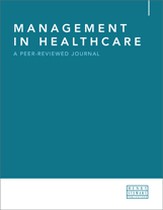Bringing joy and meaning back to the workplace through patient safety strategies and connected healthcare operations
Abstract
As health care continues to embrace and excel in technological and digital advancements, preventable harm, cognitive and administrative burden, and workplace violence continue to contribute to emotional exhaustion, burnout and loss of joy in our workforce. This has had profound negative impacts on our outcomes and is a barrier to providing the safest care. One solution-based framework that can address and recentre our efforts around safer, more inclusive and transparent health care is the recently introduced Centers for Medicare and Medicaid Services (CMS) Patient Safety Structural Measures (PSSM). These measures consist of the following domains: leadership commitment to eliminating preventable harm, strategic planning and organisational policy, culture of safety and learning system, accountability and transparency, and patient and family engagement. These measures will require us to refocus using available digital solutions to pull from disparate data sources to better enable our leaders and teams to understand the drivers of the context in which we work, identify disparities in healthcare delivery and outcomes, integrate a ‘just culture’, consistently use cause analysis tools and understand the themes and trends produced by these methods, be transparent and rapid in our response to harm with our teams and patients and families, and include our patients and families in the design and re-design of our systems to produce the safest care. The PSSM provide guidance, coupled with an understanding of the principles of human performance and connected data and information, and can restore joy and purpose and create long-lasting sustainable change and improvement in our health outcomes and our organisations. Software solutions offer the promise of implementing this work in ways that reduce the administrative burden and provide valuable actionable insights.
The full article is available to subscribers to the journal.
Author's Biography
Timothy B. Mcdonald , MD, JD, is the Chief Patient Safety and Risk Officer for RLDatix and an Adjunct Professor of Law at Loyola University–Chicago. As a physician-attorney who was one of the main architects of the CANDOR (Communication and Optimal Resolution) Toolkit, Tim has assisted more than 800 hospitals and health systems in implementing a culture of ‘normalised compassionate honesty’ combined with ‘fair and accountable culture’ in the prevention and response to harm in health care. This approach to harm events also includes a commitment to communicate with patients and families throughout the therapeutic relationship, provide peer support to all affected members of the team and learn and follow patient safety events. His federally funded research has focused on all these domains and their impact on improving the culture of healthcare organisations while bettering the quality of care mitigating medical liability issues. He has been intimately involved with incorporating patient safety metrics, including CANDOR principles, into software to enhance patient safety.
Jared Capouya , MD, MS, HQS is the Vice President and Chief Quality and Safety Officer at Nemours Children’s Health. Dr Capouya was trained in paediatrics at the University of South Florida and has received a degree in Healthcare Quality and Safety Management from Thomas Jefferson University. He was the inaugural Medical Director of Quality at Mary Bridge Children’s Hospital in Tacoma, Washington, and went on to lead the quality and safety programme at Arkansas Children’s health system in 2018 as the Vice President of Quality and Safety. Jared also had a leading role in their clinically integrated network, the Arkansas Children’s Care Network (ACCN) before transitioning to Nemours at the end of 2022. Additionally, he is currently the Chair of the patient safety team at the Child Health Patient Safety Organization (Children’s Hospital Association) and is a member of the clinical steering team for Solutions for Patient Safety (SPS) where he also has led various think tanks in innovation strategy and high reliability. Dr Capouya has led several implementation efforts, including population health indices, communication and optimal resolution programmes, harm reduction efforts across health systems, integrated behavioural health in early childhood, and high-reliability leadership methods and behaviours, and currently works as a paediatric hospitalist in addition to leading quality and safety efforts at Nemours.
Citation
Mcdonald, Timothy B. and Capouya, Jared (2025, September 1). Bringing joy and meaning back to the workplace through patient safety strategies and connected healthcare operations. In the Management in Healthcare: A Peer-Reviewed Journal, Volume 10, Issue 1. https://doi.org/10.69554/LBBM1060.Publications LLP
